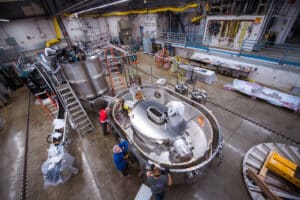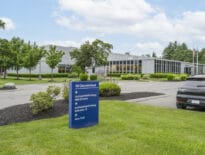
Commonwealth Fusion and MIT workers assemble a superconducting magnet inside a test stand at MIT. A recent successful test of the magnet has opened the door for commercial-sale fusion power. Photo by Gretchen Ertl | MIT and Commonwealth Fusion
When it comes to Devens, the former Army base turned industrial park, world-shaking events don’t necessarily come to mind.
But that all changed Wednesday when Commonwealth Fusion, a startup fresh out of MIT, unveiled a groundbreaking advance in its drive to build the world’s first nuclear fusion power plant, one that would essentially bring a mini star or sun to earth and harness its power to provide electricity to homes, shops, offices and factories.
In a press conference held on Zoom, researchers at Commonwealth Fusion and MIT’s Plasma Science and Fusion Center announced a successful test of magnet technology that is the key to building a successful nuclear fusion reactor.
The test generated a sustained field of more than 20 tesla, or layman’s terms, a magnetic field strong enough to enable a fusion reactor to produce more power than it took in.
It’s a threshold goal that scientists have spent decades pursuing. And it now opens the way for Commonwealth to build a test fusion reactor, at Devens, where the startup, whose backers include Bill Gates, has started work on a 47-acre fusion research and manufacturing campus.
The magnet test results provide “a clear path to fusion power for the first time,” said Bob Mumgaard, Commonwealth Fusion’s CEO, told reporters last week. “That has never been done before – more energy out than in.”
Commonwealth said it is now on track to have a test reactor, SPARC, ready to fire up at Devens by 2025, followed by the world’s first commercial fusion reactor, possibly as early as the end of the decade.
A New World, Born?
If successful, relatively sleepy Devens may suddenly become the 21st century equivalent of Kitty Hawk, where the Wright brothers first proved it was possible to take to the skies, the birthplace of a world changing technology.
A place where schoolchildren someday, say in 2072, will go tour a museum of nuclear fusion history, where the technology was born that created the modern world and put an end to the dirty, fossil fuel world of their great-grandparents.
The potential is truly that big, and the stakes are really that large. For if the geeks at MIT succeed in building a nuclear fusion reactor, it would trigger a change even more sweeping than the rise of the internal combustion engine and electric power in the early 1900s, which sent the horse and buggy packing and banished the kerosine lamp.
First off, our carbon emissions crisis would finally meet its match, for, like its cousin nuclear fission, which is the technology behind nuclear plants now, nuclear fusion does not send plumes of soot and carbon skyward.
However, unlike the nasty radioactive waste produced by fission reactors – which lasts thousands of years – the byproduct of a nuclear fusion reactor is akin to medical waste churned out by a hospital, manageable and contaminated only for a few years.
But the ability to produce power through nuclear fusion would even be bigger than this, for it would not only clean up the electric grid, it would provide a seemingly-inexhaustible source of power that could be ramped up exponentially to meet the demands of an ever more high-tech and electricity-hungry world.
What Could Go Wrong – and Right
The ability to harness power beyond human muscles has been a central factor driving the growth of civilization and technology for the past 10,000 or so years, a journey that began with the domestication of draft animals.
Windmills and waterwheels represented another advance, with the Industrial Revolution ushering in steam engines, and later, the internal combustion engine and electricity.
But the jump from fossil fuels to nuclear fusion is likely to be the biggest leap of all, with fusion capable of producing 200 million times the energy of comparable fossil fuels, said Mumgaard, Commonwealth Fusion’s CEO.
“You can power our civilization with fusion power forever,” Mumgaard said.
The other revolutionary aspect of fusion is that since it relies on hydrogen, it can be produced anywhere.
That should reshuffle energy and political dynamics across the world, draining the power that autocratic petro-states like Russia and Saudi Arabia have wielded for years, simply because they happen to be sitting on huge oil reserves.
The development of nuclear fusion could also have impacts that go well beyond this world as well.
While interstellar travel remains well beyond humanity’s reach right now, an intermediate step would surely require spacecraft powered by mini nuclear-fusion reactors, futurists speculate.

Scott Van Voorhis
So, after the glowing write up I just gave to this project, what could go wrong?
Well, just about everything, of course. Commonwealth has yet to actually build and successfully run a test reactor, let alone a commercial power plant that generates electricity for the masses.
A lot will have to go right for the company’s plans to take off, and, even if they eventually do, it could take years, or maybe even decades, longer than anticipated.
Or maybe the final breakthrough will happen somewhere else, with some lab in California or France robbing Commonwealth Fusion – and its budding, 47-acre Devens research complex – of all the glory.
But that said, researchers at Commonwealth and MIT have passed a crucial threshold.
And the possibilities are truly mind-blowing.
Scott Van Voorhis is Banker & Tradesman’s columnist; opinions expressed are his own. He may be reached at sbvanvoorhis@hotmail.com.




 |
| 
